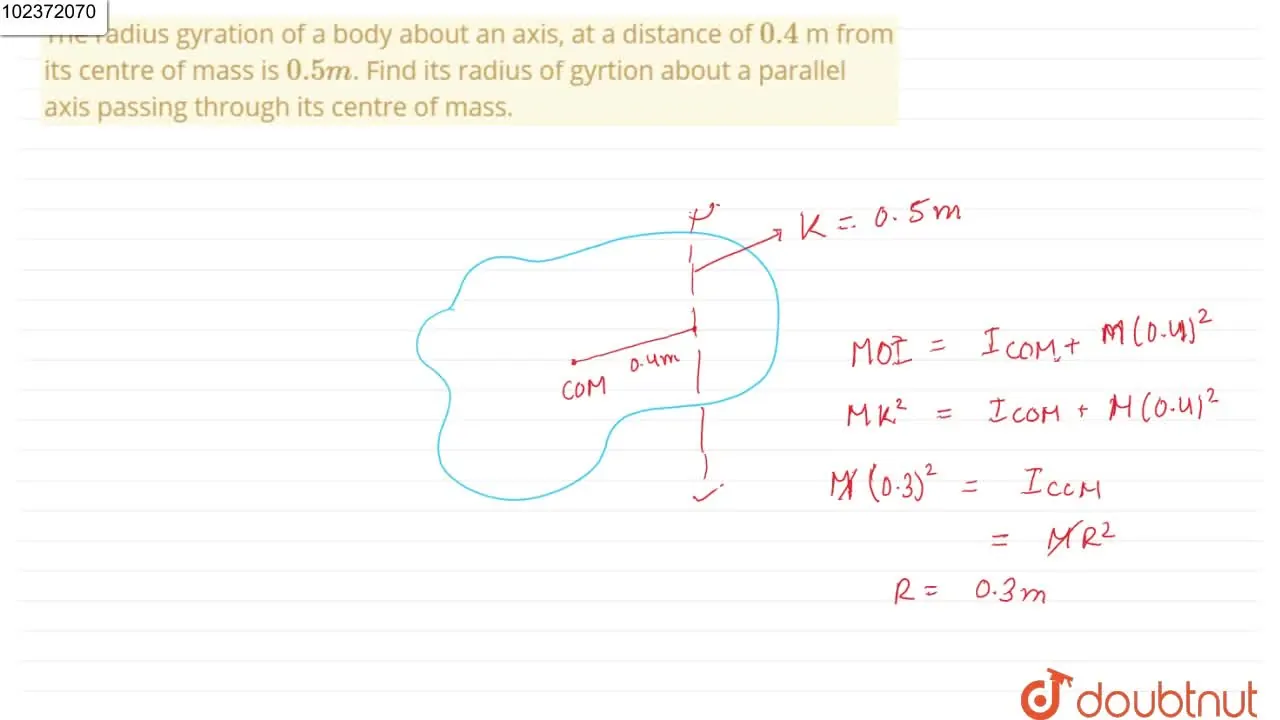Explain the formation of stationary waves by analytical method. Shwo that nodes and antinodes are equally spaced in sationary waves.
The radius gyration of a body about an axis, at a distance of 0.4 m from its centre of mass is 0.5m. Find its radius of gyrtion about a parallel axis passing through its centre of mass.
Consider two simple harmonic progressive waves, oif the same amplitude A, wavelength λ and frequency n=ω/2π, travelling along the x-axis in opposite directions. They can be represented by
y1=Asin(ωt−kx) (along the +xaxis) ....(1)
and y2=Asin(ωt+kx) (along the -xaxis) ....(2)
where k=2π/λ is the propagation constant.
By the superposition principle, the resultant displacement of the particle of the medium at the point atwhich the two waves arrive simultaneously is the algebraic sum
y=y1+y2=A[sin(ωt−kx)+sin(ωt+kx)] .....(3)
Now, sinC+sinD=2sin(C+D2)cos(C−D2)
∴y=2Asinωtcos(−kx)=2Asinωtcoskx ......(4)
[∵cos(−kx)=cos(kx)]
=2Acoskxsinωt ......(5)
where R=2Acoskx.
The above equation shows that the resultant wave is a simple harmonic wave of amplitude |R| and having the same period as that of the individual waves. The absence of the terms−+kx in the sine function and ωt in the cosine function implies that the resultant wave does not propagate along the positive or negative x-axis.Hence, it is called a stationary wave. In this case there is no energy transport.
The absence of the term in t in the cosine function shows that each particle vibrates with a fixed amplitude |R| that varies periodically, only with x.
Nodes and antinodes : The points at which the particles of the midum are always at rest are called the nodes.
At nodes, R=0
∴cos(2πx)λ=0 (:'A≠0and k=2πλ) ....(6)
∴2πxλ=π2,3π2,5π2,7π2,.....
∴x=λ4,3λ4,5λ4,7λ4,....,(2p+1)λ4,....., where p=0,1,2,....
Therefore, the distance between successive nodes is
[2(p+1)+1]λ4−(2p+1)λ4=λ2 ....(7)
The points at which the particles of the medium vibrate with the maximum amplitude are called the antinodes.
At antinodes, R=−+2A
∴cos(2πx)λ=−+1 .....(8)
∴2πxλ=0,π,2π,3π,....
∴x=0,λ2,λ,3λ2,.....,pλ2,..., where p=0,1,2,...
Therefore, the distance between successive antinodes is
(p+1).λ2−pλ2=λ2 ......(9)
∴ Distance between successive nodes=distance between successive antinodes =λ/2.
Thus, the nodes and antinodes occur alternately and are equally spaced.
Related Playlists
- BOOK - NAVNEET PUBLICATION - MAHARASHTRA BOARDCHAPTER - DERIVATIONS-IEXERCISE - Kinetic Theory of Gases and Radiation5videos
DERIVATIONS-I
- BOOK - NAVNEET PUBLICATION - MAHARASHTRA BOARDCHAPTER - DERIVATIONS-IEXERCISE - Assignments9videos
DERIVATIONS-I
- BOOK - NAVNEET PUBLICATION - MAHARASHTRA BOARDCHAPTER - DERIVATIONS-IEXERCISE - Wave Motion2videos
DERIVATIONS-I
- BOOK - NAVNEET PUBLICATION - MAHARASHTRA BOARDCHAPTER - DEFINITIONSEXERCISE - COMMUNICATION SYSTEMS3videos
DEFINITIONS
- BOOK - NAVNEET PUBLICATION - MAHARASHTRA BOARDCHAPTER - DERIVATIONS-IIEXERCISE - Assignments9videos
DERIVATIONS-II
Similar Questions
The radius of gyration of a body about an axis at a distance of 12cm from its centre of mass is 13cm. Find its radius of gyration about a parallel axis through its centre of mass.
View SolutionRadius of gyration of a body about an axis at a distance 6 cm from its centre of mass is 10 cm. Find its radius of gyration about a parallel axis through its centre of mass.
View SolutionThe radius of gyration of a body about an axis at a distance of 6 cm from the centre of mass is 10 cm. What is its radius of gyration about a parallel axis through its centre of mass?
View SolutionThe radius of gyration of a body about an axis at a distance of 4cm from its centre of mass is 5cm. The radius of gyration about a parallel axis through centre of mass is
View SolutionThe radius of gyration of a body about an axis at a distance of 4 cm from the centre of gravity is 5 cm. Its radius of gyration about a parallel axis through centre of gravity is
View SolutionThe radius of gyration of a body about an axis at a distance of 6 cm from the centre of gravity is 10 cm. Its radius of gyration about a parallel axis through centre of gravity is
View SolutionRadius of gyration of a body about an axis at a distance 6 cm from it COM is 10 cm . Its radius of gyration about a parallel axis passing through its COM is (n) cm . find value of n.
View SolutionRadius of gyration of a ring about a transverse axis passing through its centre is
View SolutionThe radius of gyration of a uniform rod of length L about an axis passing through its centre of mass is
View SolutionThe radius of gyration of a uniform rod of length L about an axis passing through its centre of mass is
View Solution


